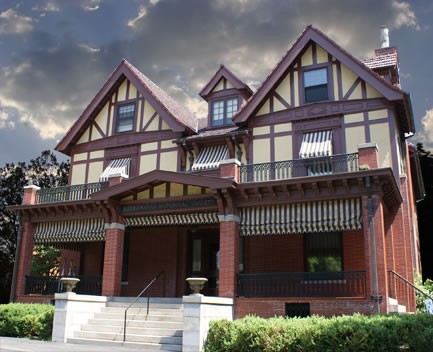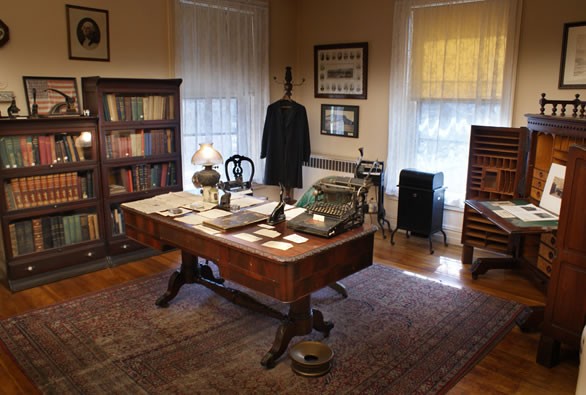Lackawanna Historical Society George H. Catlin Memorial House
Introduction
Text-to-speech Audio
The Lackawanna Historical Society is headquartered at the George H. Catlin Memorial Home in Scranton's historic Hill Section and within the campus of the University of Scranton. Designed in 1912 by architect Edward Langley for Scranton financier George Henry Catlin and his wife Helen, this stately Tudor Revival-style home features walnut woodwork, molded plaster ceilings, brass lighting fixtures, a three-paneled stained glass window, and six fireplaces. The three-story home serves the Society as a museum and accommodates office space, a research library, exhibit rooms, storage rooms, and a lecture area.
Images
Lackawanna Historical Society is located in the historic home of George and Helen Catlin.

One of the rooms includes a reconstruction of a coal executive’s office. Other rooms include mining equipment and artifacts related to the Civil War.

Backstory and Context
Text-to-speech Audio
Founded in 1886 as the Lackawanna Institute of History and Science, the Lackawanna Historical Society provides the community with a record of local history through its museum and library collections, exhibits and programs. In 1965 Lackawanna County designated the Society as the official county historical society. Today, we continue to serve as a center for local history resources, which are organized and maintained at our headquarters, the historic Catlin House. These resources are used to implement public educational programming and interpret the region’s rich history. Popular events include the annual local history game show “You Live Here; You Should Know This!”, summer downtown walking tours, Children’s Day at the Catlin House, Historic Hill House Tour and many more.
The Catlin House, officially named the George H. Catlin Memorial House, is located at 232 Monroe Avenue in Scranton and is adjacent to the city’s downtown. Designed in a Tudor revival style by architect Edward Langley in 1912, it was the primary residence of Scranton financier George Henry Catlin and his wife Helen and has served as the headquarters for the Lackawanna Historical Society since 1942. The Society maintains weekly hours at the Catlin House, including Saturdays, and is open to the public for touring, conducting research and attending monthly lectures and educational programs. An architectural gem, the home features black walnut woodwork, oak parquet flooring, and molded plaster ceilings. The first floor of the Catlin House displays original period furniture that belonged to the Catlin and Archbald families. Changing exhibits can be found in many rooms as well. The kitchen and service area, located in the rear of the house, has been converted for use as the Society’s library/research space. The bedrooms on the second floor have been converted into exhibit spaces showcasing the history of Lackawanna County. Closets and servants quarters, located in the rear, now serve as collections storage space.
With a vast collection — including artifacts, photographs, maps, textiles, artworks, manuscript materials, books, films, and oral histories — the Society serves as the county’s collective memory. Our research library, museum, digital platforms, educational programming, and historical publications make Lackawanna County’s history accessible to all. With strong support from both public and private sectors, we offer a broad array of programs that create meaningful opportunities for scholarship, creative projects, learning, teaching, and community building — all centered around the county’s long, complex history.
Sources
Lackawanna Historical Society. "Looking Back & Moving Forward: Strategic Plan 2020-2024". Scranton, PA. 2020.
Lackawanna Historical Society. "The Catlin House: A Curriculum Guide for the Historic Home of the Lackawanna Historical Society". Scranton, PA. Lackawanna Heritage Valley, 2000.
